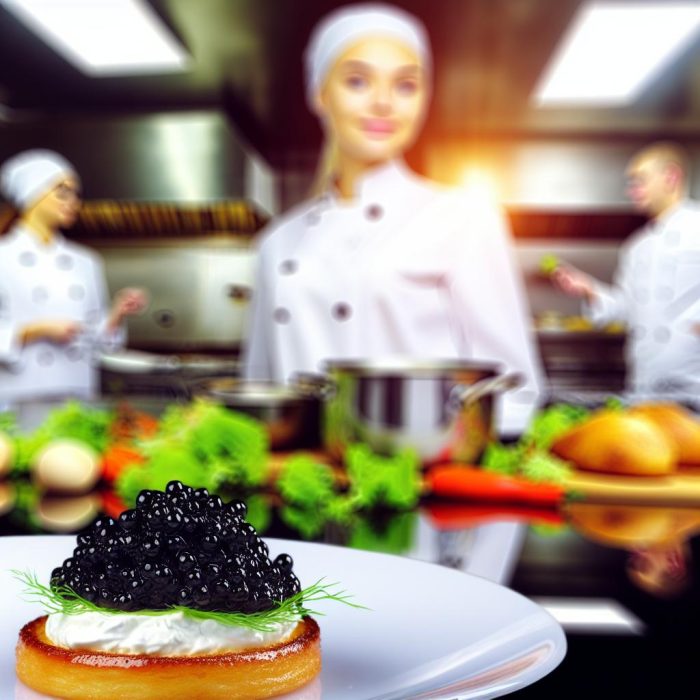Introduction to Caviar in Haute Cuisine
Caviar, a delicacy consisting of salt-cured fish eggs, primarily from sturgeon, holds a prestigious position in haute cuisine. Traditionally associated with luxury and elegance, caviar is prized for its unique texture and distinct flavor profile. In haute cuisine, it’s not just a garnish; it’s an ingredient that defines the dish. This reflection on caviar’s prominent status among gourmet delicacies underscores its importance and the elaborate nature of its use in fine dining. Understanding the distinctiveness of caviar allows one to appreciate its contribution to the culinary arts and the sophisticated palates it serves.
Types of Caviar
The world of caviar is diverse, with different types offering varied flavors and experiences. The most celebrated varieties of caviar are Beluga, Osetra, and Sevruga. Each type has unique characteristics determined by the species of sturgeon from which it originates. These characteristics significantly influence their distinct roles and uses within haute cuisine, allowing chefs to utilize them in ways that best complement their dishes.
Beluga Caviar
Beluga caviar is widely regarded as the highest quality of caviar, derived from the Beluga sturgeon. It is particularly valued for its large, delicate eggs and buttery texture. The taste of Beluga caviar is mild yet rich, offering a subtle flavor that discerning palates celebrate, often enjoyed on its own to fully appreciate its nuances. This type of caviar frequently holds center stage in dishes where its taste can be experienced unimpeded by other flavors.
Osetra Caviar
Osetra caviar provides a stronger flavor when compared to Beluga. It features mid-sized eggs that can vary in color from golden to brown and is celebrated for its unique nutty undertones. These characteristics make Osetra an excellent choice for enhancing a variety of dishes such as salads, pasta, or seafood, where its rich taste can be both a highlight and a complement to other elements on the plate.
Sevruga Caviar
Sevruga caviar, the smallest of the three, is noted for being the most abundant. Its intense, briny taste is preferred in culinary creations that require a bolder caviar flavor. Sevruga caviar is often incorporated into canapés and hors d’oeuvres, where its robust flavor can stand out and provide an impactful taste sensation that is both impressive and memorable.
The Role of Caviar in Haute Cuisine
Caviar’s role in haute cuisine is inherently multifaceted. As chefs strive to create exceptional dining experiences, caviar is used to enhance both the visual appeal and the depth of flavor in numerous dishes. Beyond the traditional pairing with blinis and crème fraîche, caviar finds its place integrated into various culinary creations, showcasing its versatility and the artistry involved in its use.
Garnishing and Pairing
When used as a garnish, caviar can elevate a dish through its luxurious presence. It’s frequently paired with other high-quality ingredients, such as smoked salmon, wagyu beef, and lobster. In choosing pairings, chefs aim to create harmonious taste combinations, opting for foods with creamy or subtly flavored bases that will complement the robust flavor of caviar, ensuring that it enhances rather than overwhelms the dish.
Incorporation into Dishes
Some chefs incorporate caviar directly into the composition of their dishes, allowing its rich flavor to meld seamlessly with surrounding elements. Dishes such as caviar-topped scrambled eggs or caviar-infused sauces illustrate its versatility. These culinary creations not only highlight the flavor of caviar but also add an intriguing textural layer due to the popping sensation it provides, contributing to a multifaceted dining experience.
Beverage Pairings
In haute cuisine, pairing caviar with the appropriate beverage is crucial to enhancing the overall experience. It is often matched with champagne or vodka, both of which have complementary qualities that can accentuate caviar’s flavor profile. Additionally, some chefs prefer to pair caviar with dry white wines, which can further enhance its delicate taste and bring out its nuanced flavors, making the consumption of caviar a complete and enhanced sensory journey.
Conclusion
Caviar’s esteemed position in haute cuisine is well justified by its unique taste, texture, and the elegance it brings to any dish. Through careful integration and thoughtful pairing, it continues to be a cherished ingredient that encapsulates the luxurious essence that is central to haute cuisine. Those with an interest in a deeper exploration of how caviar is utilized in fine dining are encouraged to consult expert perspectives, such as those provided by culinary resources like Chefs Pencil for further insights, which delve into the intricacies of this prized delicacy.

